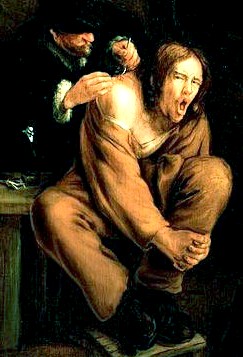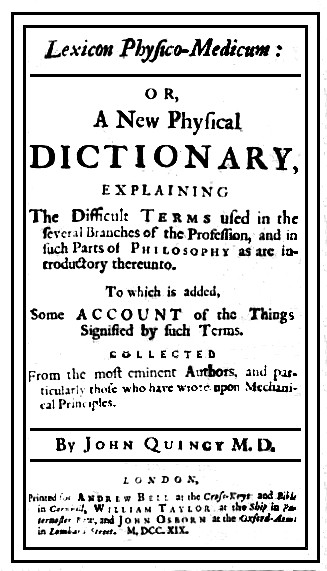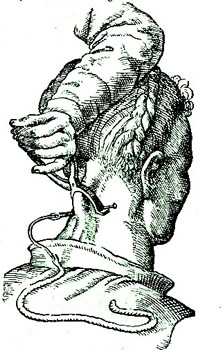
Fontanels: Issues and Setons Page Menu: 1 2 3 4 5 6 Next>>
Fontanels: Issues and Setons in the Golden Age of Piracy, Page 1
"Issues are made in many Infirmities and Diseases; especially in great pains of the Head, in several Distempers of the Eyes and Teeth, Noise and Deafness of the Ears, the Gout, old Ulcers, Fistula's... Apoplexies, Falling Sickness, Dizziness of the Head, in tumified Legs, Ischiatick Pains, Lameness, and in several other Diseases, wherein if they have been of long continuance, they are very Beneficial." (Matthias Gottfried Purmann, Chirurgia Curiousa, p. 305)

Artist: Gerrit Lundens
Surgeon Making Incision in Patient's Back
From the Wellcome Collection (1649)
Fontanels, issues and setons were used as a way to allow bad fluids (usually referring to bodily humors) to escape from the body. Although the three terms vary and there are some small differences in what each meant the method was similar for each: a wound was kept open and irritated through artificial methods to encourage the collection of undesirable fluids in the body in one place so that they could be removed. The majority of period medical writers generally refer to such cures as fontanels, in reference to their behaving like a fountain for unwanted substances in the body.
One type of fontanel, the seton, dates back to the 6th century BC and is still in use today. During the golden age of piracy, fontanel use revolved around humor theory, which will be discussed in detail in this article.
A variety of tools were used to create fontanels and keep them open. These include cauterizing irons, caustic chemicals, cutting implements such as scissors and knives, forceps, threads (also referred to as setons), needles and a pea. These tools were used to create and maintain fontanels, the procedure for each of which will be explained.
As the quote leading this section suggests, fontanels were used to treat a wide variety of health problems - some of them temporary, and others for long-term diseases or health conditions. When the physician or surgeon felt that a patient required, a fontanel would be left open and producing fluids for extended periods of time - sometimes years or decades. Such issues would have to be kept clean, medicated and bandaged. Their location was also important to its efficacy as well as the comfort and needs of the patient.
Most surgeons during the golden age of piracy used fontanels occasionally and some used them a great deal. The last part of this article will look at the variety of health issues where period surgeons and physicians recommended fontanels. It will look in detail at fontanel use in problems of the eyes, fistulas, head wounds, twitching extremities, swelling and tumors, wasting members and wounds, ulcers and abscesses.
Fontanel, Issue or Seton?
Understanding the difference between the three names can be a little challenging. Some period authors seem to use the terms interchangeably. However, other period authors indicate that these terms refer to slightly different things. In his medical dictionary, John Quincy defines a fontanel as "strictly a little Spring; and is used to express [mean] Issues, Seatons, or any such like artificial Discharges."1 The 'little Spring' expresses the idea that the bad humors flow out of the wound like a spring of water coming out of the ground. According to Quincy, then, setons and issues were subclasses of fontanels. Ephraim Chambers' Cyclopaedia says that fontanels (which he calls fontinculus or fonanellas) are "a general name for issues, setons, and the like other small artificial discharges."2 He also hearkens to the concept of a fountain or spring as well as the notion of setons and issues being subsets of fontanels.

John Quincy's medical lexicon doesn't provide a definition for issues. Writing during the period, Charles Gabriel Le Clerc explained, "An Issue is an Ulcer in the Skin, made by Causticks applied on it."3 Le Clerc's definition is rather broad, although he curiously restricts the method of opening the skin to caustic medicines. (We will see that there were several ways to make an issue, including using existing sores or wounds.)
In his Cyclopaedia, Ephraim Chambers defines issues as "small artificial apertures in a fleshy part of the body, to draw off superfluous moisture, or give vent to any noxious humour."4To further confuse matters, sea surgeon John Woodall uses the terms fontanel and issue interchangeably.5
Issues were originally open wounds that were created and then allowed to heal naturally after suppurating, or forming pus. By the 16th century, these wounds were being intentionally kept open by the insertion of foreign objects, often referred to as peas, which included a variety of small items such as round metal pieces, seeds or beads.6
Setons were more definitely defined. According to Quincy, they are created "when the Skin is taken up with a needle, and the Wound kept open by a Skein of Silk, that Humours may vent themselves; for the same purposes as Issues, tho' generally with more Efficacy."7 The silk thread is left in the skin to irritate and cause infection, thus creating the 'fountain', which produces pus and other bodily fluids thought to be the 'bad' humors gathering and flowing out of the body.
German military surgeon Matthias Gottfried Purmann gives a similar definition, "Setaceum or a Seton is much of the same Nature with a Fontanel, only it has two Orifices which are made with a Needle and a Skean of Silk drawn through the fleshy Pannicle of the Neck, and is kept open by the Skean of Silk being drawn once or twice a day from one side to the other"8. Unlike Quincy, Purmann suggests that setons were not subclasses of fontanels, but the two words meant different things. He notes that a seton had two orifices - or cuts in the skin - which allowed the thread to pass beneath a flap of skin created by the cuts and irritate (and thus infect) it.
Purmann also explains that setons are only placed in the back of the neck. Nathan Bailey's etymological

Artist: Marcus Severinus
Seton Needle Insertion in Neck , From Opera
quae
extant omnia, by William Fabry (1682)
dictionary concurs, noting that a seton is "a sort of issue in the neck, &c."9 Several other period and near-period lexicons and dictionaries agree with this.10
However sea surgeon John Atkins is not so restrictive about placement, defining a seton as being "of the same Design with Issues... They may be drawn through any fleshy Part, but commonly on the Back of the Neck."11 French surgical instructor Pierre Dionis simply refers to a seton as "small String run thro’ a Wound from its beginning to its end"12, similarly not restricting its location.
Curiously, Dionis suggests that setons are the same as tents - small pieces of fabric used to keep a wound open to allow healing and release of humors from a wound, "because both are used to the same intent; and that the effect of the latter has a great Affinity with that of the former."13 In fact, this is more like an issue, where a pea is inserted into the skin when the surgeon wishes to keep the wound open for a longer period of time.
At the end of all these various explanations, the only thing that is clear is that the definitions were not completely clear at this time. However, the majority of the authors from the golden age of piracy appear to agree that fontanels are any wound in the skin used to allow the escape of bad humors (or laudable pus) from the body. Issues are wounds that are opened in the skin to allow the escape of fluids from the body. Setons are pieces of thread drawn though an incision in the skin, often in the back of the neck, and left there to irritate the skin. Issues and setons are both subtypes of the more general term fontanel.
However, it must also be recognized that not all the period authors follow these definitions.
1 John Quincy, Lexicon Physico-Medicum, 4th ed, p. 172; 2 Ephraim Chambers, Cyclopaedia, Vol. 1, 5th ed., not paginated; 3 Charles Gabriel Le Clerc, A Description of Bandages and Dressings, London, 1701, p. 35; 4 Ephraim Chambers, Cyclopaedia, Vol. 1, 5th ed., not paginated; 5 John Woodall, the surgions mate, p. 10; 6 John Kirkup, The Evolution of Surgical Instruments; An Illustrated History from Ancient Time to the Twentieth Century, p. 403; 7 Quincy, p. 416;8 Matthias Gottfried Purmann, Churgia Curiosa, p. 22-3; 9 Nathan Bailey, The Universal Etymological English Dictionary, 2nd ed., not paginated; 10 For examples, see John Harris, Lexicon Technicum, Vol 1, 4th ed, not paginated and Ephraim Chambers, Cyclopaedia, Vol. 2, 5th ed., not paginated; 11 John Atkins, The Navy Surgeon, p. 180; 12,13 Pierre Dionis, A course of chirurgical operations: demonstrated in the royal garden at Paris. 2nd ed., p. 20
Fontanel History
Fontanels first appear in the traditional Hindu Ayurvedic medicine in Kshara medicine, which deals with destructive methods for causing healing. The fontanel is specifically mentioned by Sushruta in his Sanskrit text Sushruta Samhita from the 6th century BC to treat a fistula-in-ano (an abnormal passage - fistula - that terminates in the anus). The procedure is not fully described by Sushruta, although the word 'sutra' originally meant thread.1

Hippocrates
Three centuries later, Hippocrates advised the use of setons as one of four methods for treating a fistula-in-ano. He does explain the procedure in detail:
Taking a very slender thread of raw lint, and uniting it into five folds of the length of a span [the distance from the tip of the thumb to the tip of the middle finger], and wrapping them round with a horse hair; and having a director (specillum [a needle-like probe]) of tin, with an eye at its extremity, and having passed through it the end of raw lint wrapped round as above described, introduce the director into the fistula, and, at the same time, introduce the index finger of the left hand per anum; and when the director touches the finger, bring it out with the finger, bending the extremity of the director and the end of the threads in it, and the director is to be withdrawn, but the ends of the threads are to be knotted twice or thrice, and the rest of the raw threads is to be twisted round and fastened into a knot.2
He goes to advise that the thread is to be twisted and tightened every day to eat through the fistula wall. If the thread becomes 'putrid' and rots, "you must attach another piece of raw thread to the hair, pass it through, and tie it, for it was for this purpose that the hair was rolled round the raw lint, as it is not liable to rot."3
Being one the most revered of medical writers, Hippocrates idea was carried forward by other 'ancient' physicians. In the second century A.D., Aulus Cornelius Celsus reiterated Hippocrates' procedure, basically following the original outline, adding that "the thread itself ought to be crude, double or treble, and twisted so as to form one string... for in this manner it gradually cuts the skin above the fistula; and while the part left by the thread gradually heals up, that part which is corroded by it is divided. This method of cure is tedious, but not painful."4

School of Salerno - Schola Medica Salernitan, From Avicenna's Canons
Paulus Ægineta wrote about Hippocrates' procedure in the 7th century, although he advises against it in favor of opening the fistula wall with a cutting instrument. "For by avoiding an operation, in addition they [the surgeons who use this method] incur the inconvenience of a slow recovery."5
By the golden age of piracy, use of the seton in operating on fistulas-in-ano was at a low ebb, being mentioned only by a few surgeons.
Although its fistula-in-ano usage may have waned, the seton gained new life in fifteenth century where physicians of the School of Salerno in Italy mention it in their writings. Modern surgical history author John Kirkup explains "setons came into vogue in the fifteenth century for cranial disorders, especially hydrocephalus, migraine, and epilepsy, and for cataracts and other visual complaints."6 It continued to be used for these purposes during the golden age of piracy.

Paulus Ægineta
The classical authors mention creating issues with cautery irons, which were used to allow the "bad" humors to be expelled. As a last resort in chronic epilepsy, Celsus advised the surgeon to use "a
hot iron... to make an eschar in two places, in the
back of the head, and below, where the first vertebra is joined to the head; that by these the noxious humour may be discharged."7 Citing other classical authors, Paulus Ægineta suggested using cauteries on the skull for various problems including favid (a disease producing swollen, honeycomb-like pustules on the skull)8, "asthma, consumption [tuberculosis] and all cold defluxions from the head to the chest."9
In the period following the Salerno teachings, various other uses for non-seton fontanels were discovered and written about, particularly as their "fountain" like expulsion of purulent matter dovetailed with the belief that a person who was ill needed to be purged of bad humors. Modern surgical tool author Elizabeth Bennion notes, "This treatment was an extension of the practice of deliberately keeping wounds open for the exit of 'laudable pus', based on the theory first derived from Galen and which lasted until [Joseph] Lister [1827-1912]."10
While the issue gradually disappeared from medicine, the seton gained new life in the late 19th century as prominent physicians of the time researched ways to treat fistulas-in-ano.11 As a result, the seton is still in use today. Several recent trials have studied its efficacy with positive results.12
The modern procedure uses two setons. One is "tied tightly as a cutting seton and another [is] loosely tied for drainage purposes."13 This procedure makes use of both the method recommended by Hippocrates to cut the fistula wall as well as the humor-based theory of providing a way for unwanted fluids to drain from the wound. The results of one study pronounced that use of such a seton "is safe, cheap and effective in the treatment of anal fistula regardless of type. It does not leave an open wound and most patient are satisfied with the treatment."14
1 Compiled from various wikipedia entries gathered 3/8/15 including Sushruta Samhita, Ayurveda and Kshara; 2 Hippocrates, Hiipocratic Writings, Translated and Edited by Francis Adams, p. 312-3; 3 Hippocrates, p. 313; 4 A. Cornelius Celsus, Of Medicine in Eight Books, Translated by James Grieve, p. 266-7; 5 Paulus Ægentia, The seven books of Paulus Ægineta, Translated by Francis Adams, p. 400; 6 John Kirkup, The Evolution of Surgical Instruments; An Illustrated History from Ancient Time to the Twentieth Century, p. 403; 7 Celsus, p. 170; 8 Paulus Ægentia, p. 97; 9 Paulus Ægentia, p. 250; 10 Elizabeth Bennion, Antique Medical Instruments, p. 69; 11 Juan L. Poggio, "Fistula-in-Ano," Medscape.com, gathered 3/9/15; 12 See for example Cheong Ho Lim, Hyeon Keun Shin, Wook Ho Kang, Chan Ho Park, Sa Min Hong, Seung Ky Jeong, June Young K and Hyung Kya Yang, "The Use of a Staged Drainage Seton for the Treatment of Anal Fistulae or Fistuous Abscesses," Journal of Korean Society Coloproctology, Dec 2012, p. 309-14; and Theerapol Angkooolpakdeekul, So Bok Yan, and Mgoi Shing Siang, "Routine Use of Setons for Treatment of Anal Fistula," The Thai Journal of Surgery, 2002, 45-6; 13 Angkooolpakdeekul, Yan, and Siang" p. 45; 14 Angkooolpakdeekul, Yan, and Siang, Abstract Results

